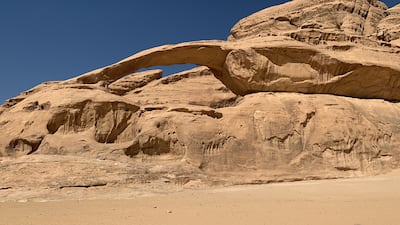
A dirt track nicknamed Disney Road.

Yanal Abdulaziz Al Zawaidah sitting at the spot where Matt Damon set up his camp in 'The Martian'. All photos: Razmig Bedirian / The National

Recreating a scene from 'The Martian'.

Al Zawaidah, a local of Wadi Rum, helps international production companies scout for filming locations and also guides tourists across the desert.

The spot where Rey battled Kylo Ren in the ninth 'Star Wars' film.

The rocky arch featured in the 2019 live action remake of 'Aladdin'.

A rock formation nicknamed The Face for its contours.

A rock formation nicknamed Titanic for its boat-like appearance.

An area commemorating the base that Prince Faisal bin Al-Hussein and his Bedouin army established with Thomas Edward Lawrence in 1917.

Seashells can be found across Wadi Rum, proving that the desert was underwater millions of years ago.

Some of the rocks in Wadi Rum can be used to extract natural makeup.

The French fortress located in the northern part of Wadi Rum.

Sun City Camp is one of the luxury camping destinations at Wadi Rum.

Each tent is air-conditioned and equipped with a queen-sized bed, spacious bathroom and breathtaking views of the surrounding desert.

The bathroom in one of the Sun City Camp tents.

The plastic windows are cool to the touch, despite being subject to direct sunlight all day.

One of the dome tents in Sun City Camp.

A dirt track nicknamed Disney Road.

Yanal Abdulaziz Al Zawaidah sitting at the spot where Matt Damon set up his camp in 'The Martian'. All photos: Razmig Bedirian / The National

Recreating a scene from 'The Martian'.

Al Zawaidah, a local of Wadi Rum, helps international production companies scout for filming locations and also guides tourists across the desert.

The spot where Rey battled Kylo Ren in the ninth 'Star Wars' film.

The rocky arch featured in the 2019 live action remake of 'Aladdin'.

A rock formation nicknamed The Face for its contours.

A rock formation nicknamed Titanic for its boat-like appearance.

An area commemorating the base that Prince Faisal bin Al-Hussein and his Bedouin army established with Thomas Edward Lawrence in 1917.

Seashells can be found across Wadi Rum, proving that the desert was underwater millions of years ago.

Some of the rocks in Wadi Rum can be used to extract natural makeup.

The French fortress located in the northern part of Wadi Rum.

Sun City Camp is one of the luxury camping destinations at Wadi Rum.

Each tent is air-conditioned and equipped with a queen-sized bed, spacious bathroom and breathtaking views of the surrounding desert.

The bathroom in one of the Sun City Camp tents.

The plastic windows are cool to the touch, despite being subject to direct sunlight all day.

One of the dome tents in Sun City Camp.

A dirt track nicknamed Disney Road.
The Martian mystique that makes Jordan's Wadi Rum a moviemakers' favourite
When directors want to recreate the red planet on Earth, they know where to come

Razmig Bedirian
19 August, 2022
- Listen In English
- Listen In Arabic